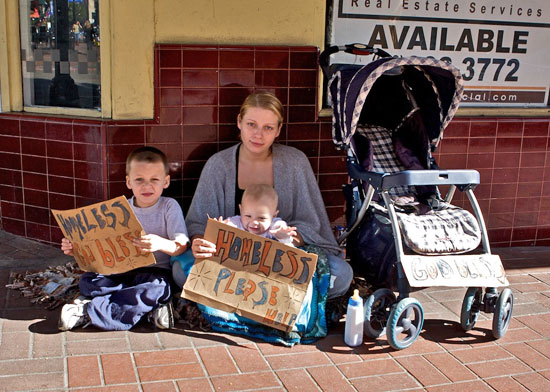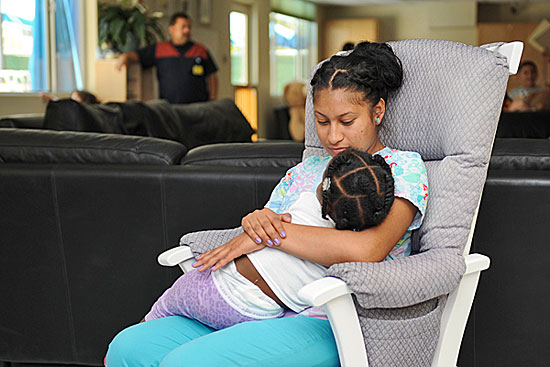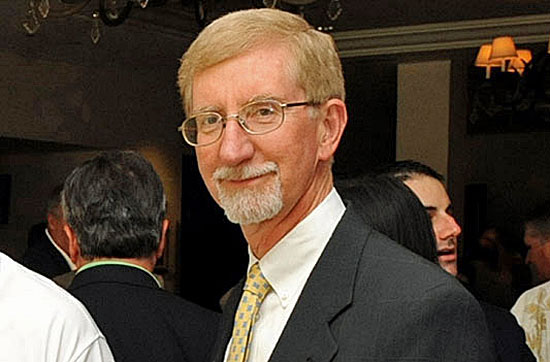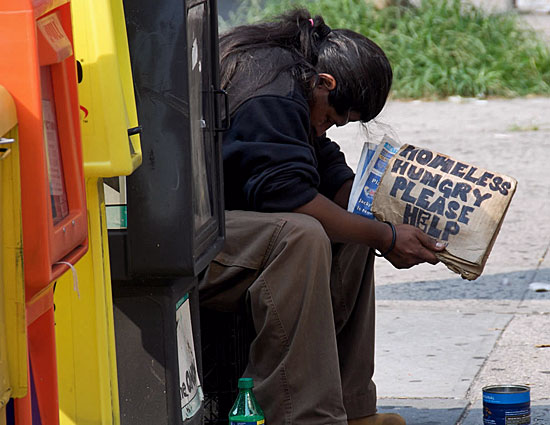Top Story: Social Services
New hope for our tiniest homeless
August 30, 2012

A $25 million committment by First 5 LA holds the promise of housing and services for young homeless children.
There are an estimated 3,000 children—5 years old and younger—who endure lives of homelessness every day in Los Angeles County. By all measures, they face a bleak future. According to studies, homeless youngsters are 12 times more likely to end up in foster care, and they’re twice as likely to suffer learning disabilities. By the age of 12, large numbers of them will have witnessed a violent event.
This week, the First 5 LA commission began developing the framework for an unprecedented “fast-track” effort to end this tragic cycle by committing $25 million to place families of these vulnerable youngsters in permanent supportive housing.
“There is a tremendous social cost for nearly 3,000 of our youngest children to be left without a safe, stable home every night,” said Supervisor Zev Yaroslavsky, who earlier this year became First 5 LA’s chairman. “With this program, we are focusing for the first time on helping families with children prenatal to age 5 who are struggling with homelessness daily and nightly in Los Angeles County.”
The multimillion dollar effort was initiated in July through a Yaroslavsky motion after First 5 LA released a study of the problem. It’s modeled after programs that have proven highly effective in restoring the lives of chronically homeless adults in Los Angeles and across the nation. The idea is to give a person a permanent home while surrounding him or her with a variety of services, including mental health and medical services.
A Los Angeles County analysis of the pioneering Project 50 on Skid Row showed that not only were participants benefiting, but the public was saving money on emergency rooms, jails and other costs associated with long-term homelessness. The Project 50 model, also championed by Yaroslavsky, is now being replicated throughout the region and by the U.S. Department of Veterans Affairs.
The $25 million committed by First 5 LA to house homeless children is part of a broader initiative to accelerate the expenditure of $400 million for various services aimed at the county’s babies, toddlers and preschoolers. Last year, a toughly-worded audit found, among other things, that the agency had been sitting on a surplus of nearly $800 million, prompting a change of leadership. First 5 LA and similar agencies throughout California are funded by a voter-approved 50-cent tax on tobacco products sold in the state.
At its meeting this week, the commission said it would begin soliciting applications for the funds in mid-September and start awarding the money in December.
A better place for kids to wait
August 22, 2012

A toddler gets a lullaby from a certified nurse assistant at the county's new Child Awaiting Placement Center.
The toddler in the pink shoes had arrived early Sunday, after her single father was taken into custody on a DUI. Social workers called foster home after foster home, but none would take her. One woman agreed, then reneged, saying she couldn’t handle a 21-month-old baby. A grandmother was willing, but her home wasn’t safe.
As precious hours passed, the frustration continued. But there was at least one consolation for the displaced child: For the first time in nearly a decade, tots in her situation had somewhere to wait besides the Department of Children and Family Services command post. When bedtime came, the toddler got a warm bath, a hot meal, a clean crib and a loving shelter in a brand new county center for children awaiting foster care.
Tucked into a corner of the Los Angeles County-USC Medical Center campus, the county’s new Child Awaiting Placement Center has been operating to rave reviews since July 16. The CAP Center can feed, house and care for as many as 15 children up to the age of 10 while DCFS workers canvass for foster homes.
The center opened after reports last year that DCFS was housing children in the department’s Emergency Response Command Post when social workers couldn’t find placements, and downplaying the situation because they feared repercussions from their managers.
Though the command post was created to investigate child abuse allegations on nights and weekends, it has morphed in recent years into a de facto children’s shelter; since the 2003 demise of the troubled MacLaren Children’s Center, the command post is the only DCFS office that never closes.
But the command post—a suite of offices that moved last year from a Wilshire Boulevard high-rise to the downtown L.A. Mart, which houses high-end furniture showrooms—does not have a state license to house children, and by law cannot provide shelter for more than 24 hours.
Earlier this year, county auditors reported that they had seen as many as 10 infants, children and teenagers at a time sleeping at the command post last year. Some older children had histories of violence and severe mental illness, and some babies were sleeping in car seats.
Meanwhile, auditors found, social workers were struggling to find emergency placements; on one night, 11 of 14 foster care facilities called by command post staffers simply let the phone ring; the other three were either filled, closed or had changed their phone numbers.
“We had all these kids coming in,” says DCFS Regional Administrator Frank Ramos. “And we were trying to make sure they were safe in this business office. But at the same time we also had to respond to, say, officers who just did a drug bust and had called to say, ‘We’re at the home, and we need you to come now.’ ”
Enter the CAP Center, which was conceived two years ago by Dr. Astrid Heger, who directs the county’s 24-hour hub for treating victims of child abuse. Housed in a bright, loft-like space that spans a sleeping area, a big playroom, a child-scaled bathroom, a playground and an eat-in kitchen, the center is adjacent to Heger’s clinic.
“It used to be a child care center for employees and patients at the [County-USC] Medical Center before they moved to their new hospital building,” says Heger, adding that after the move, the area reverted to storage space.
Because children who come to the command post are brought to Heger for medical examinations, she says, she saw the need coming. “All the emergency response workers who were coming in here kept saying, ‘Can’t we just leave these kids here? Because the command post isn’t a very good space for them to be in,’ ” she recalls.
Heger’s operation, a multi-disciplinary project known as the Violence Intervention Program, is publicly funded, but also is subsidized by a foundation; deciding that “if we build it, they will come,” she asked one of her private donors, children’s author Cornelia Funke, to help renovate some of the county hub space.
When the Board of Supervisors inevitably demanded action, she says, the space was prepped, thanks to Funke’s $100,000 donation. DCFS kicked in $40,000 for touch-ups, and the founders of Guess? Inc. donated furniture, adds Heger.
The proximity to VIP ensured that medical care and mental health services would be available if needed; the hospital supplied hot meals for the children. Although DCFS officials estimate the center eventually will cost about $2 million to operate with its own staff, the Department of Health Services has for now sent certified nurse assistants to cover the first two months of childcare. DHS leases the space to DCFS at no cost.
Forty-six children arrived during the center’s first week. On the first Saturday night, 14 of its 15 beds were filled. “There were sisters asleep on the couch with their arms around each other, and a teenaged mom with her 2-year-old over there on a futon,” Heger recalls. “It was the way it should be—everybody was sleeping with real pillows and blankets on real furniture.”
As of last week, CAP had sheltered 194 children, and only one—the toddler in the pink shoes—had overstayed the 24-hour limit. Meanwhile at the command post, which for now remains the waiting area of last resort for adolescents, the headcount of waiting children is down by about 40%, to roughly 50 per week.
DCFS Assistant Regional Administrator Maricruz Trevino, who moved from the command post to run the CAP Center, says the new facility is a godsend, but the county’s work is far from finished. From the strained economy to an increased reluctance among foster parents to take babies, she says, a chronic shortage of willing foster homes continues to plague the county.
“This is wonderful,” she says, as she smiles down at the toddler in the pink shoes, who beams back, proffering a little toy bowl of pretend “soup.”
“But the resources in our community have to be gathered. We have to find a place for more of our kids.”

Like the three bears and their porridge, children awaiting foster care now have a setting that is "just right."
Posted 8/21/12
A “new day” for First 5 LA
July 17, 2012
It has been less than a year since Los Angeles County threatened to take over First 5 LA.
Created by voters to channel tobacco-tax revenues into programs for babies, toddlers and preschoolers, the independent agency had been accused of sitting on more than $800 million. A scathing audit had accused the organization of mismanagement and overstaffing. Meanwhile, much-needed initiatives for local kids were falling by the wayside.
What a difference nine months can make.
Last week, the commission overseeing First 5 here approved an accelerated plan to unleash nearly $400 million for services for the county’s littlest residents.
The plan, which is expected to serve up to 200,000 children countywide over the next five years, will almost immediately expand several existing programs and create some important new ones.
Among the new initiatives: a $25 million push to launch permanent supportive housing for homeless families with small children; a $40 million expansion of dental care for children age 5 and younger, and an innovative $4.1 million partnership with UCLA to bring mobile vision care to preschoolers starting in September.
Additionally, First 5 will spend more than $100 million to partner with the county on expanded programs to bring health insurance to low-income children and to address childhood obesity, parenting problems and substance abuse among parents of young children.
That money will be tied to multi-year agreements to ensure ongoing funding, and fast-tracked to the Department of Mental Health, the Department of Public Health and other partner agencies so that they can immediately qualify for funding matches.
“What’s impressive is not just the amount of money, but the speed, which is so important in light of the needs of our 0-5 kids,” says First 5 Chief Program Officer Antonio Gallardo. “First 5 used to be known for taking forever, but all these things are primed to be implemented in the next three to six months. That’s a 180-degree turnaround from the way we used to do business.”
First 5 was created in 1998, after California voters approved Proposition 10, a 50-cent tax on tobacco products that was championed by actor-director Rob Reiner. The money was to be locally administered and dedicated to child development programs for children aged 0-5.
Almost from the start, the tax generated immense sums. In most of the state, the revenues were administered directly by the counties. In Los Angeles, however, First 5 was overseen by a county-appointed commission and run by an independent agency.
Gallardo says that initially, the money piled up because it took several years to assess needs and to set up First 5 LA, the largest of the state’s 58 First 5 organizations. But when 2011 arrived with a local surplus approaching $1 billion, the untapped pots of money in Los Angeles and several other counties that had been slow to use their share of the funds became a tempting target for Gov. Jerry Brown, who’s been saddled with a huge budget deficit. He proposed diverting half of all the current and future Prop. 10 money into the state budget for children’s health.
The proposed diversion threatened to take about $450 million from First 5 LA’s swollen reserves, plus about $50 million into the future—a prospect that not only prompted a blizzard of lawsuits, but spurred Supervisor Michael D. Antonovich to ask Harvey M. Rose Associates to conduct the independent October audit.
The audit found no malfeasance, but was highly critical of the management under then-chief executive Evelyn Martinez, who had allegedly been so conservative with First 5 LA’s money and had operated with so little oversight by its commission that the organization was “at risk of not fulfilling its mission.”
“It was almost as if they were hoarding the money,” recalls Supervisor Zev Yaroslavsky, who, as this year’s chairman of the Board of Supervisors, automatically chairs the First 5 LA commission. “But the idea was not to have the biggest bank account in the county. It was to achieve the greatest positive outcomes for children who need help.”
Martinez resigned and general counsel Craig Steele took over as interim CEO in November after the Board threatened to strip First 5 LA of its independent status. Then in March, a court challenge invalidated the state’s claim to First 5’s revenues.
Now First 5 LA is searching for a new CEO. The new spending plan is expected to whittle the surplus to $122 million this fiscal year and $90 million by 2016.
Yaroslavsky, a longtime advocate for the homeless, says he is most excited about ambitious plans to jump-start housing and wraparound services for homeless children and their often-young parents, using a template that has been used successfully to house and treat other populations of street people, such as veterans and the chronically mentally ill.
“We have 3,000 kids in L.A. County below the age of 5 who are homeless, and that’s 3,000 too many,” he says.
But the supervisor also pointed with anticipation to a $4.1 million vision care program based on one that has been a remarkable success for the past decade in San Diego County, run by Dr. Stuart Brown, an ophthalmologist affiliated with both UCLA and UC San Diego. Brown says he expects to build on a small UCLA vision-mobile program to bring ongoing vision care to at least 20,000 preschoolers a year in this county.
“There’s plenty of money left, but we have moved a considerable amount out the door for programs and kids who need them,” says Yaroslavsky. “It’s a new day for First 5 LA.”
Benched Lakers star still on a mission
May 8, 2012

Billboards like this represent the continuing collaboration between Metta World Peace and Los Angeles County.
“I was 110 percent wrong,” the suspended Laker says of decking an opposing player with a nasty elbow to the head. “People can say what they want. I’m not going to get down on myself because I made a mistake. I’m not perfect. But it’s not going to stop me from talking about mental health.”
And the Los Angeles County Department of Mental Health suddenly has a teachable moment on its hands.
For more than a year, the player formerly known as Ron Artest has been in a very public partnership with the mental health department, appearing at high school assemblies and in public service announcements to encourage young people to be unafraid of seeking psychological treatment. Dozens of billboards and transit ads with World Peace’s picture, along with the NBA logo and the L.A. County seal, carry the catchphrase: “You can do it.”
The campaign was, in a sense, testimony to the public rehabilitation and redemption of Artest, who was famously suspended for 86 games for brawling with fans in the Detroit Piston’s arena in 2004 when he played for the Indiana Pacers. Last year, World Peace—who credits a team of therapists for helping him with everything from parenting skills to anger management—was honored with the NBA’s good citizenship award.
But on Sunday, April 22, that goodwill vanished the moment James Harden of the Oklahoma City Thunder crumpled to the hardwood of Staples Center. World Peace had been pounding his chest after a dunk when he let loose with a powerful round-house elbow behind the left ear of Harden, who’d come face-to face with the pumped-up Lakers forward.
The fallout was swift. World Peace, suspended for 7 games, was widely criticized on TV, talk radio and internet postings as a thug who’d lost the right to be called World Peace, a fraud who preached mental health but who indulged his demons. He was, they said, back to being Ron Artest.In an a column for ESPN.com, former Lakers’ great Kareem Abdul-Jabbar put it like this: “In returning to his old ways, Metta has wasted all the goodwill, including the J. Walter Kennedy Citizenship Award, he earned when he was on his best behavior.” A sports columnist for the Orange County Register, Jeff Miller, was equally harsh, saying that World Peace had “tainted all the good things he has achieved in promoting mental health.”
But inside the Los Angeles County Department of Mental Health, the view was decidedly more nuanced. Experts there emphasized that mental health recovery is a process often accompanied by relapse.
“When I saw what happened in the game, I thought, man, the adrenaline just got out of control,” said Dr. Marvin Southard, the department’s director. “It was an ugly event but it seemed to me that it was not purposeful, rather an artifact of the emotion of the moment.”
For all of us, Southard said, “our aspirations and desires to do the right thing don’t always live up 100 percent to our actions…It doesn’t happen all at once. The goal is for the actual self to get closer to the ideal self day by day.”
As for the agency’s partnership with World Peace, Southard said: “I don’t feel embarrassed that the department is connected to someone who makes a mistake. I don’t know who hasn’t made one.”
For his part, World Peace said in an interview with Supervisor Zev Yaroslavsky’s website that the incident occurred simply because he got “over excited” after slamming down several dunks that reminded him of his performance as a younger player.
“I never thought I could reach that plateau again,” he said, adding: “It was pure excitement.”
World Peace said that, with his much improved game, he’s now working “all the time” with his therapist to keep from getting overtaken by emotion, as he did last month and in his earlier years. “She’s trying to show me how to play with less passion and still be effective.”
And that’s no easy lesson, he said, because this is “no kids’ game. I know people who throw more elbows than me. It doesn’t feel like a game to us. It feels like life or death.”
As he tries to reconcile the disconnect between his public image and his public mission, he can’t help feeling that he’s being judged more harshly than he should be in the situation.
“The only issue I have is people trying to single me out, trying to tarnish what I’m trying to do in the community. They try to destroy everything I’m working for.”
And those things, he said, “are bigger than basketball.”
Posted 5/8/12
Browning tapped for DCFS turnaround
February 14, 2012

Philip Browning brings management turnaround expertise to his new Children and Family Services post.
When it comes to overhauling the county’s long-troubled Department of Children and Family Services, Philip Browning isn’t messing around with any halfway measures.
“What I’d like is within two years to be the national leader, for L.A. County to be the model for other jurisdictions in the child welfare area,” said Browning, shortly after being named to the agency’s top job Tuesday by the Los Angeles County Board of Supervisors. “That’s my goal.”
Browning has been at the helm of the agency for the past six months as interim director. He was originally recruited to come to Los Angeles County in 2001 from Washington, D.C., where he served as the district’s child support director. His first assignment here was to remake the District Attorney’s child support division, one of the most troubled in the nation. With Browning in charge, collections increased 36%, to more than $500 million, as customer service improved dramatically.
“We got more complaints about child support than any other agency in the county before he arrived,” said Board of Supervisors Chairman Zev Yaroslavsky. “He turned it around and now we get virtually no complaints.”
Next up for Browning in 2007 was running the county’s sprawling and complex welfare agency, the Department of Public Social Services. Under his leadership, the department not only kept up with a mushrooming caseload but also radically reduced its error rate in signing people up for food stamps.
“He is a turnaround artist. He’s proven his ability to take a troubled department and turn it around,” Yaroslavsky said, noting that Browning did not apply for the DCFS position but was sought out by the Board of Supervisors.
He hasn’t wasted any time in his new assignment, as he seeks to make over an agency plagued with a series of highly-publicized lapses in protecting vulnerable children under its care.
A dormant strategic plan has been reawakened, with thousands of the department’s 7,300 employees submitting suggestions for initiatives and action items. Browning expects many of them to volunteer to take on new duties as the plan turns into reality.
Meanwhile, monthly meetings with top managers have been shaken up in a big way, with statistics from each DCFS office beamed up onto two huge screens for all to see. It’s part of a “data dashboard’ approach that not only introduces some healthy peer pressure and accountability to the proceedings but also makes it easier for managers to exchange ideas for solving each other’s problems.
“It’s pretty interesting to see the discussion,” Browning says.
He’s also looking for ways to remake the department’s emergency response command post system, which struggles to place children, especially teens and infants, in safe situations after hours.
“They see so many kids late at night that are so difficult to place,” he says. While the overall issue is complex, some simple fixes might be possible—such as forming a foster parents’ association that could help identify families willing to take late-night placements, or providing diapers or extra money to families willing to take on the challenge of caring for an infant.
And he’s getting ready to reorganize. “I’m foreseeing some pretty significant changes,” he says.
When Browning came in as DCFS’ interim director in August, he was the department’s third interim director in nine months. The previous permanent chief, Trish Ploehn, departed amid an uproar over high-profile child deaths and questions about whether the department was being open with policy-makers and the public. Browning’s appointment to the $255,000-a-year post is effective Thursday, Feb. 16.
Browning has a master’s of social work degree, but acknowledges he doesn’t have a deep background in child welfare.
“I think my value is management,” he says. “I see myself as an implementation guy.”
He said that over the course of his career, a variety of assignments—from running a grocery store to managing units responsible for U.S. Navy reserve logistics—have given him the tools to get things done.
Even as he’s thinking big at DCFS, Browning is stressing a simple set of principles to his new workforce.
“Common sense, critical thinking and accountability: I think almost anything you do falls within those parameters,” Browning says. “I have to be accountable, and our staff has to be accountable.”
Posted 2/14/12
Going big against homelessness
January 31, 2012

A new push to fight homelessness is underway, with county departments banding together to get the job done.
Acknowledging that solving the multifaceted problems of the nation’s largest homeless population calls for bigger and more concerted action, supervisors on Tuesday created Los Angeles County’s first interdepartmental council on homelessness.
The council will bring together county departments serving children, families and veterans along with those specializing in everything from mental health and housing to criminal justice and social services.
Board chairman Zev Yaroslavsky, who proposed the council along with Supervisor Mark Ridley-Thomas, said its creation will allow the county to take its efforts against homelessness “to a whole new level.”
“Getting this kind of centralized communication among departments, not just within departments, gives us a real opportunity to do something special,” said Yaroslavsky, who will serve as chair of the new council, with Chief Executive Officer William T Fujioka acting as vice-chair.
Los Angeles County, already a focus of national attention because of the size and complexity of its homelessness problem, will use the new interdepartmental team to “scale up” successful programs that have been so far tried on relatively small scales, according to the motion by Yaroslavsky and Ridley-Thomas.
The motion was unanimously approved, along with amendments offered by Supervisor Don Knabe. Those amendments require an evaluation of the council at the two-year mark; mandate that the council develop its plan using existing resources; and instruct the CEO to inventory and review “outcomes, findings and best practices that resulted from the board’s investment of $100 million to prevent and end homelessness” since 2006.
That earlier push, called the Los Angeles County Homeless Prevention Initiative, has led to pilot projects such as Project 50, which has taken a “housing first” approach to assisting some of Skid Row’s most vulnerable chronically homeless people. Another program, called Access to Housing for Health, has moved frequently hospitalized homeless people into housing where health care services are available.
Although the 2011 Greater Los Angeles Homeless Count report estimates a 3% drop in the county’s homeless population since 2009, it nevertheless depicts a large and troubled population of 51,340, including growing numbers of veterans and the aging.
Against that backdrop, national homeless advocates said interdepartmental and interagency councils can offer important advantages in getting things done.
“Homelessness is a cross-cutting issue,” said Steve Berg of the National Alliance to End Homelessness. If agencies and departments aren’t working together, he said, “you don’t get the kind of results you should get.”
And because there’s rarely enough money to adequately meet all the needs of the homeless population, bringing together diverse service-providers can “create efficiencies while serving people better,” said Laura Green Zeilinger of the United States Interagency Council on Homelessness, a model for the new county council.
Such collaborations, she said, can also make it easier to pursue funding opportunities, set priorities and create a better dynamic for solving problems.
As the council begins its work, it’s clear that people far beyond L.A. County will be watching.
“I definitely think that what Los Angeles does can influence other counties,” said Nan Roman, president and CEO of the National Alliance to End Homelessness. “I think it’s very promising.”
Posted 1/31/12
Audit reveals flaws in children’s agency
October 26, 2011
 More than a dozen years ago, California voters, by the slimmest of margins, passed a measure championed by actor/director Rob Reiner imposing a 50-cents-per-pack tax on cigarettes to infuse huge sums into programs aimed at lifting the lives of children 5 and under.
More than a dozen years ago, California voters, by the slimmest of margins, passed a measure championed by actor/director Rob Reiner imposing a 50-cents-per-pack tax on cigarettes to infuse huge sums into programs aimed at lifting the lives of children 5 and under.
“This is a sweet victory,” Reiner elatedly proclaimed after a final tally of absentee ballots had given his Proposition 10 the edge. “It means so much for the young children of this state…”
But this week in Los Angeles, the mood was far more somber as the Board of Supervisors received a highly critical audit of how hundreds of millions of dollars of that money has been administered locally by an independent public agency called First 5 LA.
Although no malfeasance was uncovered, the board was so concerned about the findings that, by a 4-1 vote, it set in motion a plan to strip First 5 LA of its independence and turn it into a county agency, like the majority of its companion organizations across the state.
The audit, requested by Supervisor Michael D. Antonovich, who’s currently serving as chairman of the First 5 LA commission, was performed by Harvey M. Rose Associates and bluntly details a series of risks that the firm says may be undermining the performance and integrity of First 5 LA. Among the findings:
- First 5 LA has been significantly under-spending its revenues, placing the organization “at risk of not fulfilling its mission and goals to the extent possible and consistent with the Board of Commissioners policy and program objectives.” With a fund balance of more than $800 million, the organization has spent comparatively less on its programs than California’s other First 5 groups.
- The First 5 commission receives such insufficient information from the organization’s staff that its ability to oversee spending, program activity and outcomes is compromised. “Most grant and contract awards, representing hundreds of millions of dollars of annual agency expenditures, are not submitted for approval or review.”
- In the last fiscal year, the agency awarded more than $200 million in contracts, but failed to report them all to the First 5 commissioners, which “raises the risk of agreements being in place for inappropriate purposes or with unqualified vendors or grantees.” In fact, the commission approved only 28% of First 5 LA contract awards. In many cases, contracts were awarded without competitive bidding—and without notifying the commission. Auditors could not determine how some contracts were awarded because documentation was not properly retained.
- The staffing of First 5 LA is high compared to other First 5 agencies and is “not configured to best enable development and administration of new programs and initiatives,” thus contributing to the under-spending problem and delays in launching health, safety and educational programs for the county’s children.
- During the past four fiscal years, First 5 LA has had an annual staff turnover rate ranging from 8 to 19 percent a year, generally higher than other First 5 organizations surveyed by the auditors. This, along with the absence of a commission-approved compensation policy, “raises the risk of First 5 LA not being able to attract and retrain qualified, high-performing employees.”
After the audit findings were presented during Tuesday’s Board of Supervisors meeting, Supervisor Zev Yaroslavsky offered a particularly blunt assessment.
“The lack of transparency, the lack of accountability, the lack of competition in proposals, the lack of information sharing between the staff and the commission itself, any one of these things would be a bell and whistle. And all of them together is a siren,” said Yaroslavsky, who praised Antonovich for initiating the audit process.
No representatives from First 5 LA testified during Tuesday’s session. But the organization’s chief executive officer, Evelyn V. Martinez, later released a statement noting that, since 1998, First 5 LA has undergone annual independent audits of its financial statements and controls “and at no time have these audits resulted in any material findings.”
First 5 LA, she said, “takes its fiduciary responsibilities seriously and has been a responsible caretaker of the public funds entrusted to it.” While acknowledging the Board of Supervisors’ authority to exert greater control over the organization, Martinez said that “I hope we can continue to maintain our focus on improving the lives of our youngest children in Los Angeles County.”
Among chief executives of First 5 commissions in California’s 58 counties, Martinez’ annual compensation of nearly $250,000 in 2009-2010 topped the list. That included a $10,000 performance bonus.
Supervisor Gloria Molina cast the sole vote against the motion authored by Antonovich and Supervisor Mark Ridley-Thomas, which directs the county counsel and chief executive officer to prepare a proposed ordinance establishing First 5 LA as a county agency and report back within 30 days.
“I don’t see where one dollar was stolen, one dollar was misappropriated, one dollar was mishandled,” said Molina, who was chair of the First 5 LA commission during some of the audited period. (That position is held by the sitting chairman of the Board of Supervisors, a position that rotates annually. Each supervisor also appoints a member to the commission.)
Molina added: “I think it’s a shame that we are moving so drastically to take over this agency.”
The audit process began earlier this year when the governor proposed diverting half of the current and future Proposition 10 tobacco-tax money from the county commissions established to administer it. For First 5 LA, according to the Antonovich/Ridley-Thomas motion, this would divert about $450 million from its current reserves and $50 million annually in the future.
The audit, conducted in two phases, initially was intended to identify First 5 LA’s reserves and ensure the most efficient use of future allocations. But, in the end, serious issues were uncovered that led to Tuesday’s vote.
The First 5 commissions have sued the state to block diversion of funds. The case is pending.
Posted 10/26/11
Foster kids get secret admirer’s gift
July 6, 2011
 In an act of generosity so surprising that it generated national headlines, a mystery donor last month gave $10,000 to Los Angeles County, asking only that it be put to “good use.” This week, the Board of Supervisors did just that, voting to use the money for the benefit of the county’s foster children.
In an act of generosity so surprising that it generated national headlines, a mystery donor last month gave $10,000 to Los Angeles County, asking only that it be put to “good use.” This week, the Board of Supervisors did just that, voting to use the money for the benefit of the county’s foster children.
The cashier’s check, dated May 2 and drawn on a bank in Bellingham, Wash., was mailed directly to the county Auditor-Controller’s Office with a handwritten note that said: “In this time of economic difficulties, governments need all the help they can get. Please put this anonymous check to good use. God Bless.”
But the donor didn’t name a specific department for the gift, meaning that the money was headed for the county’s multi-billion dollar general fund, a fate that somehow seemed too unceremonious for the grandness of the gesture.
So Supervisors Zev Yaroslavsky and Michael D. Antonovich introduced a motion directing that the money be deposited with the Children’s Trust Fund, a non-profit organization that provides direct aid to foster children. The motion was unanimously adopted.
Operating under the auspices of the county’s Department of Children and Family Services, the organization was founded in 1968 by a group of social workers to take up the slack for services not funded by the government. According to its website, the Children’s Trust Fund last year served 5,000 foster youth by paying for, among other things, clothing, educational field trips, sports equipment, replacement glasses and dental work not covered by insurance or Medi-Cal benefits.
“This donation is going to have a positive impact on so many lives,” said DCFS’ public affairs chief, Nishith Bhatt, who added that, because Children’s Trust Fund has no administrative overhead, 100 percent of its donations go directly to services for foster children. “It’s really a unique thing.”
Meanwhile, during Tuesday’s Board of Supervisors meeting, one member of the public offered his personal appreciation for the donor’s contribution. And that led to an intriguing exchange with Supervisor Antonovich.
“I just want to say, whoever that donor is, well, thank you on behalf of all of us residents in L.A. County,” the speaker said during a period for public comment.
“He’s a very charitable person who one time served as a public official in this county,” Antonovich responded.
Surprised, the speaker asked: “So we do know who he is?”
“Yes, I know who he is,” the supervisor said. “But if he wanted you to know who he was, he would have told you.”
And with that, the board moved on to its next order of business.
Posted 7/6/11
Kobe jumps in to help homeless kids
June 8, 2011
Turning life around for L.A.’s homeless youth is a tall order. Now there’s an NBA star in the arena.
Game on.
Kobe Bryant and his wife, Vanessa, announced this week that they are throwing the resources of their family foundation into making a difference in the lives of homeless kids.
“We’re going to attack this,” Bryant said during a news conference at My Friend’s Place, a drop-in center for homeless youth in Hollywood. “We’re going to go after it and we’re going to solve it.”
The Lakers guard said he was moved by the life stories of kids he met there. “It’s heart-wrenching stuff,” he said.
Getting involved means more than just financial support, he said; it also means forging a personal connection with homeless young people.
“Basically we want to help them kick butt,” he said. “What I do in the game of basketball is easy compared to what they have to go through. What they have to go through, that’s real determination.”
Bryant said some of the specifics of what the Kobe and Vanessa Bryant Family Foundation will undertake are still being worked out. “We’re still educating ourselves on the issue because we’re kind of brand new to it. But we sunk our teeth into it, man, and we’re going to go after it.”
Supervisor Zev Yaroslavsky, who represents the area and is one of Los Angeles’ leading advocates for homeless issues, praised the Bryants for getting involved—not just for their foundation’s support but for their star quality, which helps draw greater public attention to the problem.
“Homelessness is one of the great stains on American society to this day,” Yaroslavsky said. “The richest society on earth still has hundreds of thousands of people across the country who live on the streets. Here in Los Angeles County, 48,000 homeless persons live on the streets. Almost 20% of them are veterans of the United States military; 7,000 of them are youth.”
He said the county, along with a network of nonprofit service providers, is committed to working with the Bryants to help turn those statistics around.
“This is the center of youth homelessness in Los Angeles County. And if we can solve youth homelessness in Hollywood, we’ll be a long way to solving it for the county as a whole,” Yaroslavsky said.
Bryant said it is possible to drive past homeless people on the streets of Los Angeles and not have their plight register.
“After a game, driving home, you see the issue around you but you don’t see it. It’s kind of one of those things you glance over… It’s all around us. And it’s not fair. And it’s something that we can solve, so let’s do it.”
Posted 6/8/11
















 405 bridge work causes a stink
405 bridge work causes a stink

